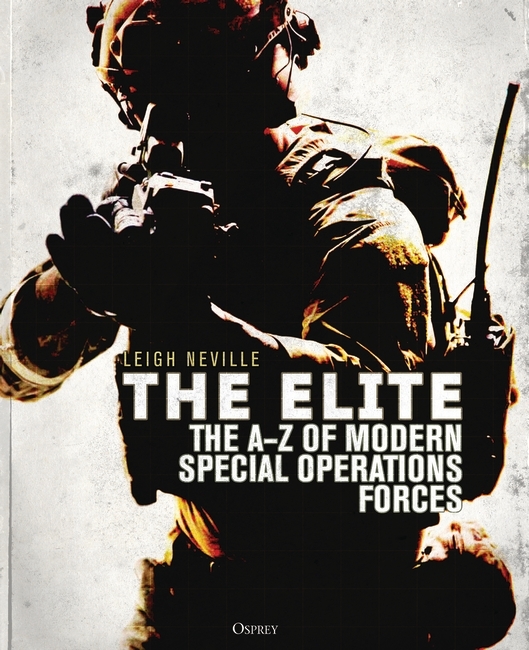Ahead of the release of his latest book for Osprey, The Elite: The A–Z of Modern Special Operations Forces, we asked author Leigh Neville to tell us about some of the units included in The Elite. In this series of five blog entries, Leigh looks at his personal top five military or police special operations forces (SOF).

Number 1
75th Ranger Regiment
I have chosen the 75th Rangers, a unit close to my heart due to my work with a number of Ranger veterans on my book on the Battle of Mogadishu, Day of the Rangers, and because it is the SOF unit which has evolved the most in the twenty years of the so-called Global War on Terror. For many years the Rangers were seen as the ‘little brothers’ of Delta, the guys who pulled security around a target while Delta cleared the objective, but Afghanistan and Iraq have seen the Regiment become far more than an elite ‘light infantry unit’. Today the 75th Rangers are capable of a full-spectrum of special operations missions.
This evolution began in Iraq with the unit graduating from securing cordons for Delta to manning its own element, Task Force Red, in the war against al-Qaeda in Iraq. Based out of Saddam’s hometown, Tikrit, the Rangers ran unilateral kill or capture missions, chalking up an impressive tally of detainees (no shots were fired on more than 90% per centof the missions), and the Regiment increasingly became adept at conducting covert entries. Without waking the neighborhood, the first a wanted insurgent would know of the Rangers’ presence was the muzzle of an M4 in their face at 3am.

75th Ranger Regiment Conducting Operations in Iraq, 26 April 2007.
Image courtesy of the US Army.
Task Force Red operated as part of the larger Joint Special Operations Command (JSOC) Task Force identified by numerical designations which constantly changed (Task Force or TF 145 for example). Each was given a colour coding and geographic responsibility for an area of Iraq. Famously, UK Special Forces were known as Task Force Black and operated principally in Baghdad (with occasional missions to Basra to support British conventional forces); Task Force Blue was to the west with a SEAL Team 6 squadron supported by a Ranger element; and Task Force Green was to the north of Baghdad and was staffed by Delta Force.
Task Force Red was comprised of a rotational light battalion of Rangers and a small troop sized element of Delta operators. When they found the number of objectives turning out to be ‘dry holes’ increasing, the Rangers realised that their quarry were spending the night in different locations to avoid the raids, so instead of nighttime strikes, the Rangers took the dangerous step of conducting daylight operations to nab their targets. Although effective, it also saw the Rangers involved in a number of protracted running firefights as entire city blocks converged on the raiders.
In Afghanistan, the Rangers were sharing command of the Afghan theatre subordinate command of the JSOC Task Force with SEAL Team 6, but their successes in both Iraq and Afghanistan saw former General Stanley McChrystal, himself a former Ranger, give operational control of Afghanistan to the Regiment, a move that ruffled more than a few feathers at SEAL Team 6. It also caused some comment from Task Force Green, as when Delta reoriented toward Afghanistan during the Surge, they found themselves playing somewhat ‘second fiddle’ to the Rangers.
In 2009, the Regiment conducted an audacious campaign to destabilize the insurgency. This campaign was known firstly as Team Darby and later as Team Merrill (both named after famous Second World War Ranger officers). The concept was simple, if extremely dangerous – insert into a known insurgent hot spot, establish a temporary combat outpost, and goad the enemy into attacking.
When the Taliban inevitably took the bait, they were hammered by artillery and airstrikes called in by the Rangers. The missions were successful in undermining insurgent control in contested areas, but came at a heavy cost – some sixteen Rangers were killed in action during the year the missions were conducted.

Rangers conducting a compound assault in Helmand Province, Afghanistan in 2011
Image courtesy of Sgt. Matthew Friberg
The Rangers are still active in Afghanistan, primarily against Islamic State-Khorasan in the east of the country, but they have also deployed in recent years to Syria, both conducting mentoring for anti-Assad forces and working as part of JSOC’s Expeditionary Targeting Force to capture or kill Islamic State high-value targets. They have also conducted some unusual missions, particularly so for a unit that tends to operate away from the limelight. Rangers in modified Stryker infantry carrier vehicles were seen in high-profile patrols flying large American flags in an effort to deconflict between Turkish and Russian forces and the Rangers’ Kurdish allies.
All in all, the 75th Ranger Regiment deserves the top spot simply because of its incredible evolution with successive leaders, and a strong NCO cadre, seeing opportunity and innovating in both tactics and equipment to match the ever-changing threat environment. Reports indicate that the Regiment is today turning increasingly to the oft-termed Great Power Competition and its impact on unconventional warfare against state actors like Russia. Ranger leaders understand that the future may well be peer or near peer conflict and are aligning the Regiment to meet the challenge.
Check out Leigh's previous blog posts about his second, third, fourth and fifth picks.
The Elite: The A–Z of Modern Special Operations Forces publishes today. Get your copy here.

Comments
You must be logged in to comment on this post. Click here to log in.
Submit your comment